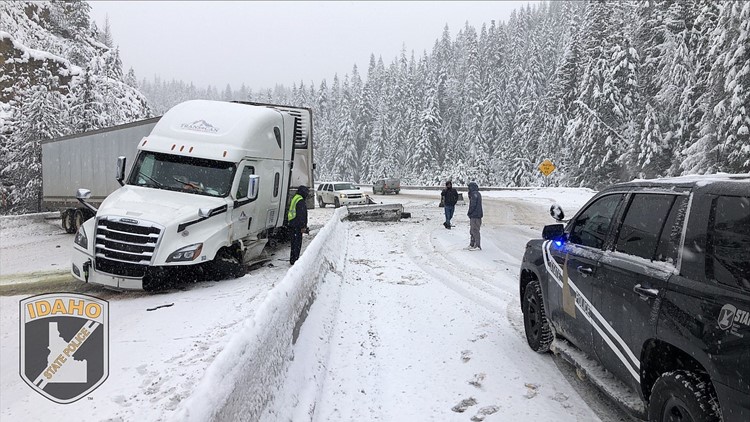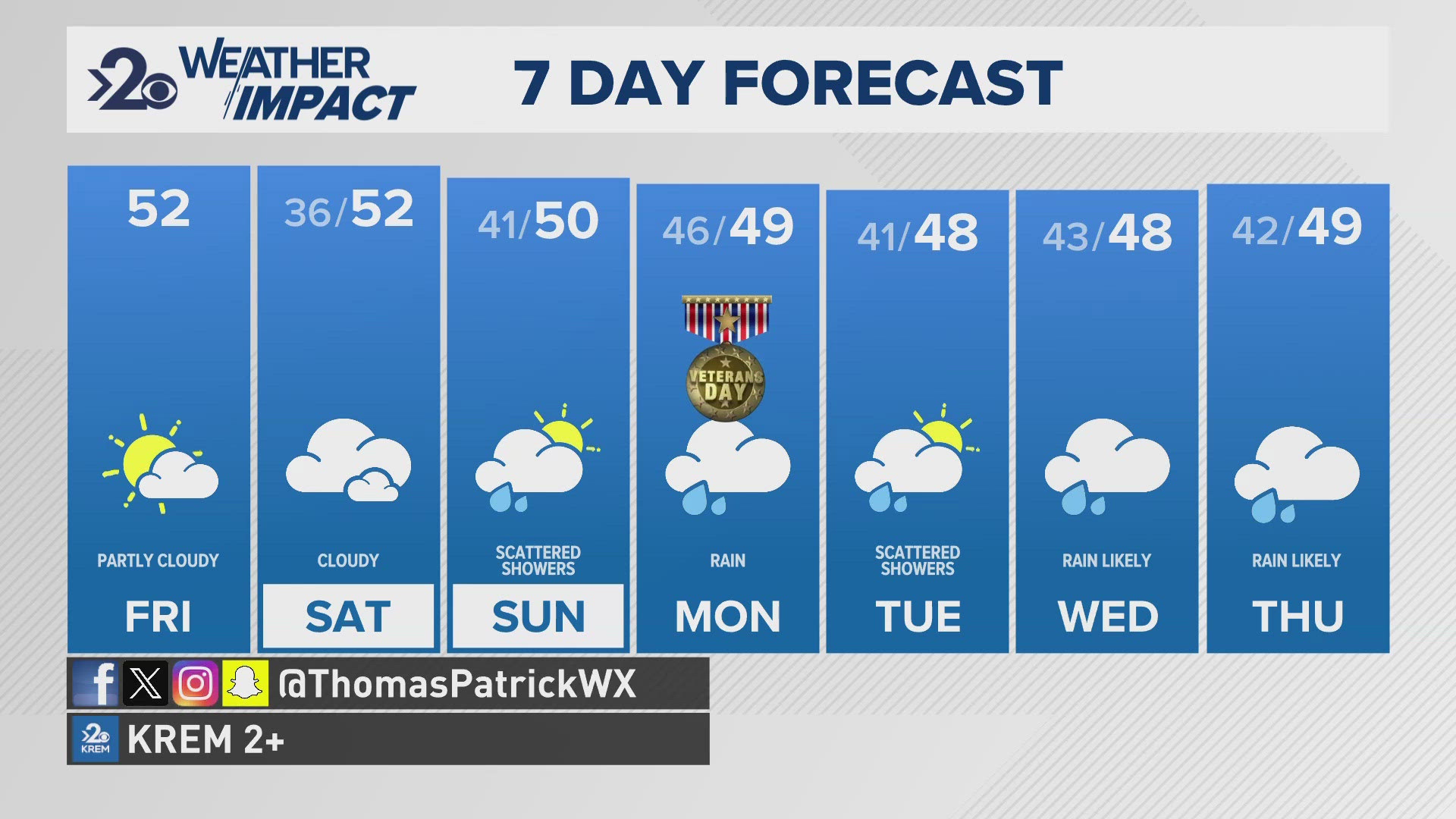COEUR D'ALENE, Idaho — Like phases of the moon, crashes on or around the only two North Idaho mountain passes during the winter months are predictable. As soon as that first real winter storm hits the ground above the snowline, some sort of Interstate 90 traffic jam on Lookout or Fourth of July Pass is sure to follow.
As anyone who has responded to, or been stuck in, one of these incidents knows — even the simplest fender bender or guard rail swipe can spiral into a multi-hour affair of clearing the roadway, as reported by our news partner the Coeur d'Alene Press.
For recent examples of this, one must only look back within the last month.
On Jan. 7, the Montana Department of Transportation announced that they had to close down I-90 from the Idaho/Montana border (Lookout Pass) east to St. Regis due to an avalanche blocking eastbound and westbound lanes between Taft and Saltese. On Jan. 6, Idaho State Police troopers were forced to completely shut down westbound traffic (and partially shut down eastbound traffic) on Fourth of July Pass for several hours after a non-chained-up semi-truck lost control on the slick roads and barreled through the center jersey barriers. Go back a little further to Dec. 11, 2021, and another full lane closure had to be implemented by ISP on Lookout Pass due to a jackknifed semi-truck in the eastbound lanes — which then caused several other minor slideouts.
While only so much can be done to prevent natural events such as avalanches and poor road conditions, more often than not, a human element is to blame.
ISP Cpt. John Kempf explains that it is a typical situation that ISP runs into on both Lookout and Fourth of July every year.
“It’s such a unique portion of interstate compared to really anywhere else that we have in Idaho because there’s very little shoulder, you have a jersey barrier that runs down the middle, and then jersey barriers on both sides.”
What also stays consistent is the hazardous conditions that snowball if even one mistake is made by any driver. Combine winter conditions with moveable barriers and no alternative routes, you have yourself a situation that can continue to get worse by the second.
“I had worked in southern Idaho where we had significant snowstorms, probably more so than we have here, but we had the tundra which was flat — there wasn’t the jersey barrier problem,” Kempf said. “When I got up here in 2016, I was shocked at how fast we went from moving traffic to dead stop one way to dead stop the other way. It doesn’t take much and it deteriorates really quickly.”
While Kempf stops just short of saying that all the blockages on the passes are caused by commercial vehicles, he admits that many of the major ones are due to their sheer size and amount of space they can take up.
According to Megan Jahns, Idaho Transportation Department public information officer, her department has recorded 106 total crashes between Wolf Lodge to Rose Lake (Fourth of July Pass) from November through February in the last five years — the bulk of which occur in December. Commercial vehicles account for roughly 19% of the average annual daily traffic on this particular pass, but 24% of the Fourth of July Pass crashes involve them.
“Most crashes (commercial and otherwise) don’t block lanes, but 26% do,” Jahns said. “For commercial crashes, it becomes more likely that lanes will be blocked and 44% over the last five years did block lanes.”
On Lookout Pass, the statistics show a similar pattern. ITD recorded 101 total crashes from milepost 64 to the Idaho/Montana state line from October through March in the last five years, 47% of which involved commercial vehicles — though they only account for roughly one-third of the traffic on that stretch.
Jahns notes that the amount of commercial traffic is consistent between both passes (about 2,500 annual average daily traffic), but passenger volumes change.
“For Fourth of July, there’s about 10,500 cars on an average day, but on Lookout there’s only 4,400 cars on average.”
Nickerson’s Towing, owned by Chad Nickerson, is one of the first tow companies that is called out to either pass when a situation occurs. Currently working through what he calls a busier than normal winter season, Nickerson points right to truckers as the main cause for the major backups.
“The No. 1 cause of all the pass closures (is) from trucks spinning out on that pass where they can’t go,” he said.
Nickerson’s belief is also shared by owner of Dechand Trucking, Richard Dechand, who has eight years of experience with driving commercial semi-trucks and has also worked as a helicopter logger for 23 years.
Estimating that he goes over both passes at least once a week in one of the four freightliners in his company, Dechand states that he always chains up (at least partially) when chain-up laws are in effect. He believes that when other truckers don’t, it’s either due to an unwillingness to do so or ignorance.
“The main reason in my opinion is that they are too (expletive) lazy,” he said. “I’m a big guy, weigh almost 300 pounds, and am lazy — but not on something like that. It just takes a few minutes to put chains on, it’s not like it is a huge production to do it.”
Dechand even said that he has helped other truckers in the past with putting chains on before hitting the passes because they didn’t know how to use them.
“I don’t know if you notice driving down the road, but you’ll see truck chains laying in the road all over the place. It’s because they don’t know how to put them on, so they put them on, then lose them before they even get to the slick part of the hill.”
With commercial vehicles accounting for many of the major pass backups and shutdowns, Kempf stressed the amount of effort troopers put into enforcing chain-up laws during this time of the year. While he added that most commercial vehicles follow the rules, it only takes one to ruin it for everyone else.
“The reason we do that is not because we enjoy writing those tickets, it’s because once we get one truck, JUST ONE TRUCK that spins out and goes sideways — going back to the jersey barrier issue — it’s a roadblock. Then no cars can pass, the plows can’t get by, even trucks that do have their chains on and are abiding by the law get stuck.”
ITD states that in Idaho, chains are only required when conditions will prevent large vehicles from traversing grades without them and the requirement is lifted as soon as possible to limit damage to the road. When the laws are in effect, ITD operators activate special roadside signs alerting truck drivers to chain up as needed.
Westbound I-90 lanes appear to be more of an issue with commercial vehicles, as Kempf said many truckers will chain-up to get over Lookout Pass, remove them when they get down, then not reapply them when they hit Fourth of July.
As far as standard passenger vehicles, ISP sees more eastbound crashes due to many drivers coming from areas that don’t prepare them for winter travel in either equipment or experience.
“I have been out there and I have had people say to me ‘I have never driven in this, I'm scared, and I’m just going to stay here,” Kempf said. “Then we tell them, ‘well, you can’t stay here, we need to plow,’ and so, as crazy as it sounds, we have people that pay a tow truck to tow them up and over the passes. It happens about every snowstorm.”
When it comes to limiting the number of crashes on the passes, Kempf stressed the basics — be prepared, slow down and stay home if conditions are too hazardous.
For the latest information on road conditions in Idaho, including mountain pass and chain-up law statuses, visit 511.Idaho.gov.
The Coeur d'Alene Press is a KREM 2 news partner. For more from our news partner, click here.



